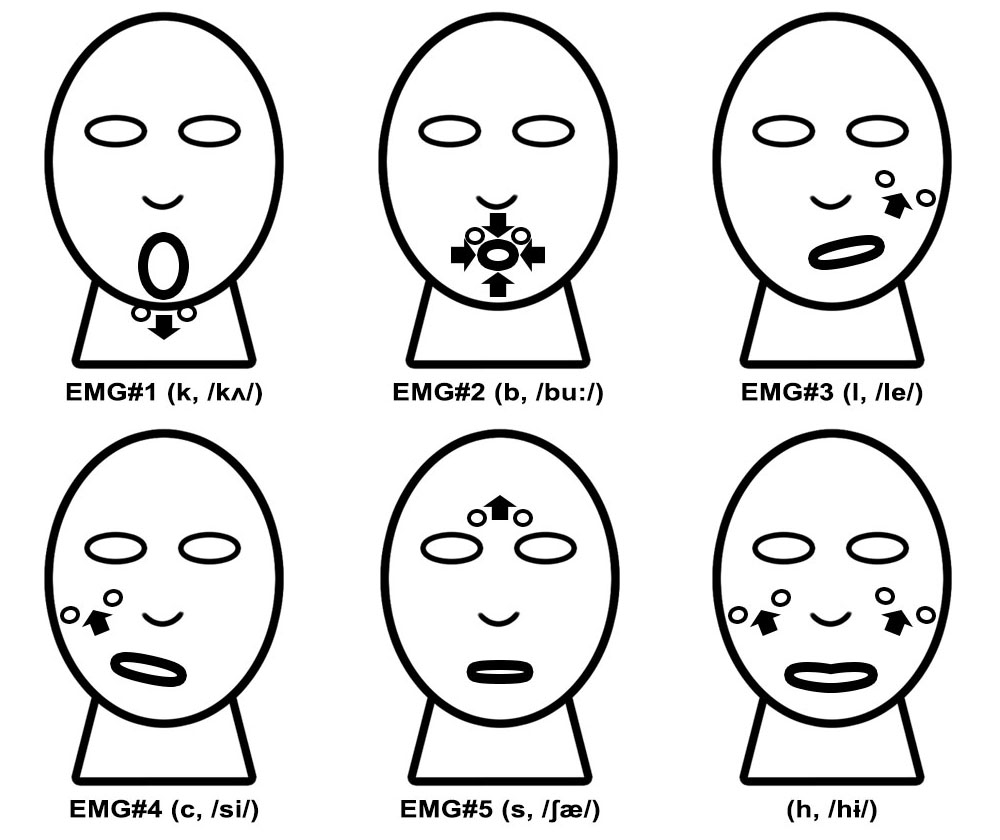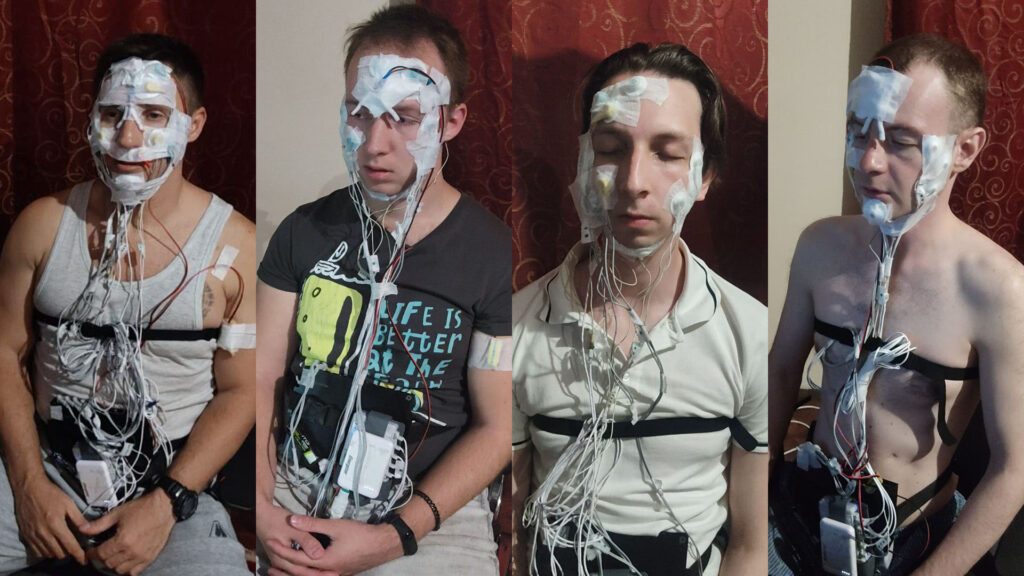Remmyo has been under development by M. Raduga since June 2021. The language helps to communicate while in phase states, like lucid dreams and sleep paralysis. It could also be used for other goals
Main principles
Even though speech can be recognized with high efficiency using electromyography (EMG) or electroencephalography (EEG), these methods don’t work for phase states because of sleep paralysis. Moreover, EMG can detect vocalizations in dreams and lucid dreams only if pronunciation involves facial muscles [1]. That’s why, in 1981, LaBerge et al. had to use Morse signals to send words from dreams by wrists [2].
Remmyo was developed to overcome these barriers. Its laboratory trials were published in a peer-reviewed scientific journal in 2023 [3]. This constructed language operates only on sounds with highly distinctive EMG traces, making it possible to literally “hear” Remmyo words in reality using sensitive sensors. Also, people can talk in Remmyo, hear it, and see it through facial expressions while awake (similar to sign language). Until English or other languages transmitted from dreams can be recognized, Remmyo can act as a substitute to accomplish different goals.
Due to sleep paralysis and issues related to consciousness and apparatus, it’s hard to use Remmyo as other languages in wakefulness. No long and complicated expressions should be used in phase states. The shorter phrases and words the better. Ideally, it is much effective to communicate in Remmyo just by using from 1 to 3 sounds in one message. With practice and more advanced technologies these limits could vanish.
Testing in REMspace lab (2022)
Etymology
Remmyo got its name from REM sleep and myo (an Ancient Greek word for muscle).
Sounds and letters
Remmyo has only 6 letters: K, B, L, C, H, and S, which could be detected by 5 EMG sensors.

K (/kʌ/) is pronounced by contracting the submentalis area
B (/bu:/) is pronounced by contracting the orbicularis oris area
L (/le/) is pronounced with contracting the left zygomaticus major area. Other facial muscles must be still.
C (/si/) is pronounced with contracting the right zygomaticus major area. Other facial muscles must be still.
H (/hɨ/) is pronounced with contracting both left and right zygomaticus major muscles. Other facial muscles must be still.
S (/ʃæ/) is pronounced with contracting the frontalis area. Other facial muscles must be still.
To speak in Remmyo, one need to follow these rules:
- Strain the target muscle (do it severely if in phase states)
- Strain only the target muscle and avoid using any other facial muscles.
- Take short breaks between letters and long breaks between words.
- Practice Remmyo while awake before applying it in phase states.
Important: if needed, any facial or body muscles could be used for Remmyo letters.
Basic grammar
Remmyo has a subject-verb-object word order and primitive grammar. Also, all vowels are skipped from spelling because they can be recognized by their paired constants (K =/kʌ/).
Tenses:
Verbs don’t have tenses. If the tense is not specified, it is present continuous because Remmyo is mostly used for real-time communication. The present and present continuous tenses are similar, but the present continuous could be specified by HK after the subject. All the ways to express tense are as follows:
K BB – I’m moving forward/I move forward
HK – Now (K HK BB – I’m moving forward)
HB – Completed/done (K HB BB – I’ve moved forward)
HL – Past (K HL BB – I moved forward)
HC – Future (K HC BB – I’ll moved forward)
Questions:
A question is formed by putting HS at the end of a sentence.
Plural:
Any word can be made plural by adding H to the end (BLC/BLCH – car/cars). An exception to this rule is that almost all words up to three letters long with and H at the end are not plural (KBH/KBHH – tree/trees).
Digits and numbers:
0 – SH, 1 – SK, 2 – SKK, 3 – SB, 4 – SBK, 5 – SL, 6 – SLK, 7 – SC, 8 – SCK, 9 – SHK
To make any number, just combine the digits:
10 – SK SH, 11 – SK SK, 12 – SK SKK, 20 – SKK SH, 21 – SKK SK, 321 – SB SKK SK.
Modes:
CCC activates or switches off the control mode, which is an alternative dictionary. This does not relate to communication but revolves around controlling actions or objects with the simplest and shortest phrases. The control mode could be preprogrammed as the main dictionary if needed.
SKB activates shortened digits (without S at the beginning) if numbers are too long. The code is used as brackets in this case: SKB L K CK B K H K K H BK SKB (5183101104). This makes sense for numbers with more than six digits. Depending on the context, SKB can simply mean number.
CL activates the Latin alphabet/dictionary and is used as brackets. This is useful when specific words or names need to be transferred by only six Remmyo letters (CL BS K KB C S CL – Paris). The mode could be preprogrammed as the main dictionary to avoid learning all other dictionaries, but it could make communication between states much less optimized: C LC LL C KK L LC BS K KB C S – I like Paris.
Slots:
KS is a permanently free slot in Remmyo language that can be changed every time. It is useful when a specific word/phrase is needed but it is not included in the Remmyo dictionary or it has too many words to pronounce.
If needed, any Remmyo word can be reprogrammed to any meaning, but other Remmyo users won’t be able to decode it without being informed about the changes.
Dictionaries
As Remmyo is constantly under development, changes could be made to either of its three dictionaries. More words will be added later if needed. New dictionaries could be added as well.
If one wishes to learn only the words they might actually use during their next phase experience, it would take just a couple of minutes to memorize them.
Basic dictionary (CSV):
Operational dictionary (CSV):
Latin dictionary (CSV):
Tips to learn the Remmyo dictionaries:
- Don’t learn what you probably won’t use;
- Start to learn gradually, starting with basic words;
- Learn clusters of words with similar meanings (colored for each starting letter);
- Some words are close to English (CKL – circle, HLK – monster/hulk, KLL – kill) or other languages (C – yes);
- Pay attention to the locations of the muscles involved in pronunciations. Sometimes they literally show the meaning (BK – down, BS – up, BL – left) or help to memorize opposite meanings (KKL – man, KKC – women; LLK – hard, LLS – easy);
- All even numbers up to 8 are created by adding K to 1, 3, 5, and 7; 0 is created by 9+K (SHK=SH+K).
Paired meanings
For optimization, some Remmyo words are paired if they have similar meanings, like BBB (between/during), KCK (error/mistake), KHK (like/love), LLK (heavy/hard), CB (see/look/observe), HLS (map/direction). All these paired words are entered in the dictionary.
Software to decode Remmyo
As of July 2022, only mLuna software can decode EMG impulses into Remmyo words, type them, vocalize them, translate them, and vocalize the translation in real time. For more information, please email [email protected]
Rights
As stated from the author, Remmyo language is free to use for any purpose (public domain).
References
1) Raduga, M. (2022). ‘I love you’: the first phrase detected from dreams. Sleep Science, 15(2), 149–157. https://doi.org/10.5935/1984-0063.20220035
2) LaBerge, S. P., Nagel, L. E., Dement, W. C., & Zarcone, V. P. (1981). Lucid dreaming verified by volitional communication during REM sleep. Perceptual and Motor Skills, 52(3), 727–732. https://doi.org/10.2466/pms.1981.52.3.727
3) Raduga, M., Shashkov, A., & Vanin, A. (2023). Unmuting Lucid Dreams: Speech Decoding and Vocalization in Real Time. Psychology of Consciousness: Theory, Research, and Practice. https://dx.doi.org/10.1037/cns0000353












